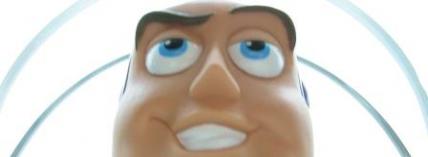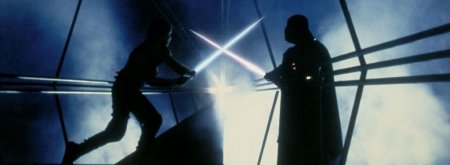Toy Story 3
As Andy leaves for college, Sheriff Woody (Tom Hanks), space ranger Buzz (Tim Allen) and what remains of the old gang confront the reality that they may never be played with again. What is a toy to do? Leave to find a new home? Stay and face the attic, perhaps even the trash? They end up somewhere far worse, "a place of ruin and despair": day care.
Just a Piece of Plastic?
In fifteen years of feature films, Pixar have only made two sequels: Toy Story 2 and Toy Story 3. With Cars and Monsters Inc. set to receive the same treatment, one might wonder if this new strategy will shackle the studio's renowned originality. But if the third instalment of this poignant saga is anything to go by, Disney-Pixar sequels will only enhance the charm of the original features. Toy Story 3 adroitly achieves the balance of hilarity and emotion, continuity and novelty, necessary to bring this classic tale to a satisfyingly bittersweet end.
Andy isn't the only one to have grown up over the course of these films. In the first two, we saw a loveable but somewhat egocentric Woody. Back in 1995 he hated Buzz for stealing Andy's attention away from him, and in 1999 he was captivated by the sight of Woody memorabilia and the thought of being immortalised in a museum. 2010 reveals a changed toy, one who argues, "it isn't about being played with; it's about being there when Andy needs us". In Toy Story 2, Woody was reminded that his boot bears Andy's name, and that fact is now firmly embedded in his mind as well. He believes that he has a responsibility to his owner, one which he is prepared to fulfil regardless of Andy's treatment of him.
The other toys still have a self-orientated bent; being played with is their top priority. With Andy's departure looming and the failure of 'Operation Play Time', the motley crew of playthings begin to panic. Woody and Buzz remind them that even if all else fails they will at least be together. Buzz's motto – that their friendship is 'for infinity and beyond' – is a deeply reassuring one, particularly in the face of such uncertain circumstances. Woody's stalwart loyalty to Andy is exemplary, but then he is the favourite toy. When Andy chooses to take only Woody to college, the sheriff's commitment to his plastic friends is tested.
Andy's collection of toys has dwindled over the years, culled for yard sales, toy donations and spring cleans. The remnant (excluding Woody) embrace a new home, Sunnyside Day Care Centre, where they meet dozens of abandoned toys who appear to have formed a loving community of their own. Their pink, strawberry-scented leader, Lots-O'-Huggin' bear (Ned Beatty), cheerfully explains, "We're all cast-offs here." Lotso has a tragic back-story: his owner lost him and then bought an identical bear to take his place. He felt "lost, cast off, unloved, unwanted". Screenplay co-writer (and director of Toy Story and Toy Story 2) John Lasseter describes the tragedy that comes to every toy:
When you're broken, you can be fixed; when you're lost, you can be found; when you're stolen you can be recovered. But there's no way to fix being outgrown by the child.[1]
"No owners means no heartbreak", according to Lotso. He reasons that all toys are better off "owning themselves". This is an attitude prevalent in our society. Rejection and abuse of trust – be it political, economic or personal – has bred cynicism and self-reliance. To commit oneself to another is to risk being let down.
The truth is that this philosophy hasn't fostered community or freedom among Sunnyside's residents. Lotso's desire for autonomy has corrupted him, causing him to curb the freedom and safety of other toys to secure power for himself. He rules the centre through insecurity and intimidation, telling his minions that they are worthless rejects and forcing new toys to face the onslaught of hyper pre-schoolers alone. Sunnyside has become a prison, and it works by perpetuating heartbreak, not removing it.
Lotso is defined by his past. He treats people according to his view of himself, and since he believes "we're all just trash, waiting to be thrown away", he uses toys as if they are expendable. One of Lotso's henchmen, Ken, who naturally falls for Andy's Barbie, eventually sees through his boss' propaganda:
Lotso: You think you're special, cowboy? You're a piece of plastic! You were made to be thrown away ... She's a Barbie doll. There's a hundred million just like her.
Ken: Not to me.
Professor Mary Beth Oliver, an expert on the effects of the media, said this in relation to Toy Story 3: "When we watch 'sad' films, we're really watching something that is helping us search for meaning – what is the purpose of life?"[2] This film asks, 'What were we made for?', 'Are we special?' and 'If so, to whom?' Our answers to these questions will dictate our view of ourselves and our behaviour toward others.
For Woody, the meaning of his life is inextricably linked to his owner. He is defined by Andy, and the film celebrates his faithful friendship with his master. The human desire for belonging is just as strong as – if not stronger than – the desire to avoid the pain of rejection. The Bible holds answers to the questions of Toy Story 3 and to that longing to belong to someone we trust. A first-century Christian called Peter wrote a letter to a scattered, suffering people. He told them:
You are a chosen people. You are royal priests, a holy nation, God's very own possession. As a result, you can show others the goodness of God, for he called you out of the darkness into his wonderful light.
Once you had no identity as a people; now you are God's people. Once you received no mercy; now you have received God's mercy. (1 Peter 2:9-10)
Peter, those he was writing to and millions since have seen God's name inscribed in them, and known that they are special because they are his. God's ownership is nothing like Lotso's power-hungry dictatorship; it's more like Andy's early exuberant friendship. His love brings freedom, purpose and community. Moreover, God will be faithful to us 'for infinity and beyond'.
 Film title: Toy Story 3
Film title: Toy Story 3
Keywords: Duty, rejection, autonomy, friendship, identity, purpose, belonging
Director: Lee Unkrich
Screenplay: Lee Unkrich, John Lasseter, Andrew Stanton, Michael Arndt
Starring: Tom Hanks, Tim Allen, Joan Cusack, Ned Beatty, Michael Keaton, Whoopi Goldberg
Distributor: Walt Disney Studios Motion Pictures
Cinema Release Date: 18 June 2010 (USA); 19 July 2010 (UK)
Certificate: G (USA); U (UK) Contains mild violence and scary scenes
References
[1] John Lasseter, quoted in 'Movie review: Toy Story 3', Los Angeles Times, 18 June 2010
[2] Professor Mary Beth Oliver, quoted in 'A new type of tear-jerker', BBC News, 16 July 2010
Related articles / study guides
© 2010 Holly Price



